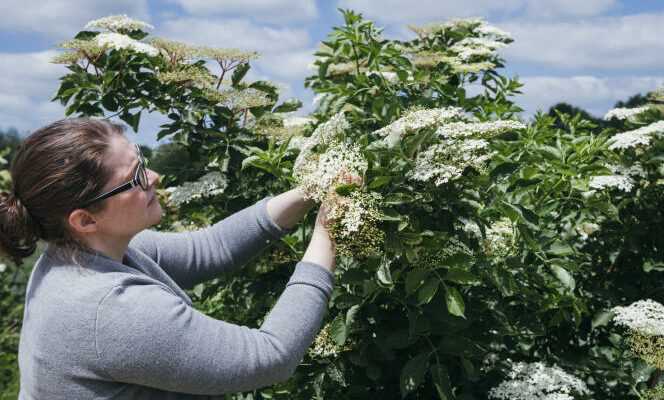Almost nothing. Tiny white spots drowned in a green ocean, which stretches in valleys, as far as the eye can see. When we follow Clotilde Brown on the paths of her family farm all in chalk and bricks placed near Housset, in the Aisne, we do not notice, at first, the elderflowers that spring has hung on the shrubs marking the way. In this corner of Picardy, nature has been organized into geometric parcels: fields of wheat, rapeseed, barley, covering hundreds and hundreds of hectares. The huge wind turbine masts are the rare vertical axes that punctuate the landscape. But, sometimes, a hedge of trees appears, which can shelter an elderberry.
“It was in England that I discovered the interest of this shrub, says Clotilde Brown. Yet there were plenty of them here, on this farm where I grew up, but no one paid attention to them. There, elderberry syrup spiced up preparations found at posh venues and garden parties: diluted with sparkling water, mixed with apple, added to frostings, wedding cakes [comme celui de Meghan Markle et du prince Harry]… Here, we did nothing. »
A graduate of the ISA, a large school in Lille which trains engineers in agriculture and agri-food, Clotilde Brown has moved away for more than ten years from the family property, where five generations before her practiced cultivation and breeding. In the United Kingdom, she worked at Tesco (a group of supermarkets) and at United Biscuits (a multinational company that notably owns BN), to study the food chain from the inside. The discovery of elderberry served as a trigger to take the tangent and return to the fold.
“I had, in the back of my mind, the idea of adding my stone to the family edifice, said the 40-year-old farmer with a smile. Grandpa had introduced the cows to the farm, Papa the hens. Me, with the elderberry syrup, I made the farm evolve towards an activity on a human scale, and with great added value. » Compared to cereal and vegetable crops (over 195 hectares) and livestock (6,600 free-range laying hens), which she must also manage, the annual production of 800 liters of elderberry syrup may seem derisory. But it conveys more meaning.
First, the elderberry brings together almost the whole family: Clotilde Brown cheerfully gathers her father and her four children around the white petals. One spring morning, all the flowers are first picked by hand, one by one, then transported to a lab set up in an old riding school on the farm. There, they are left to infuse in a large stainless steel pot. The flowers are therefore used fresh, while industrial syrups, and even many preparations that claim to be artisanal, are made from extracts, concentrates and aromas. Clotilde Brown adds organic lemon slices and local beet sugar to the recipe.
You have 52.93% of this article left to read. The following is for subscribers only.
